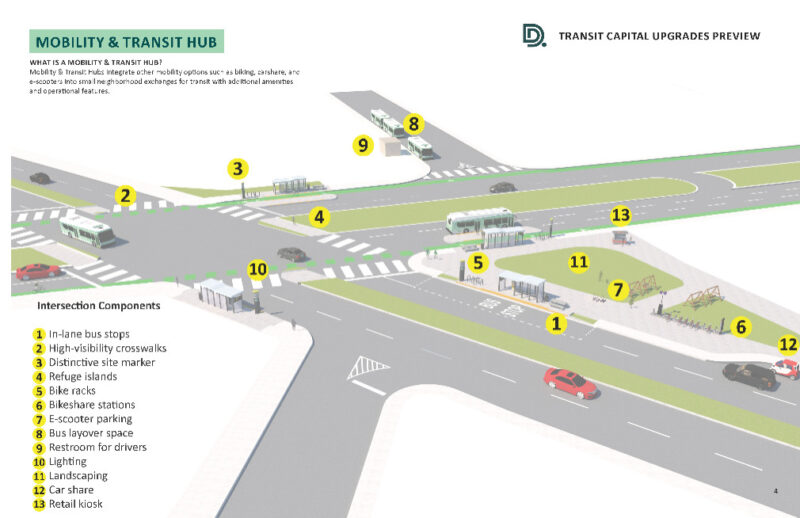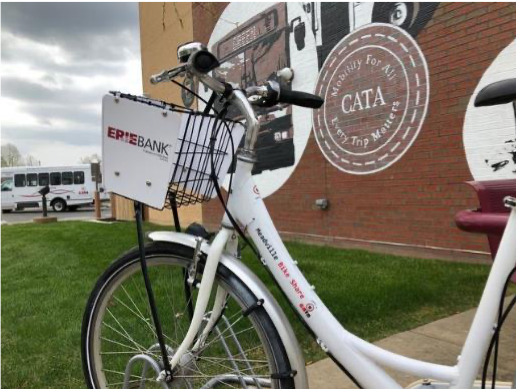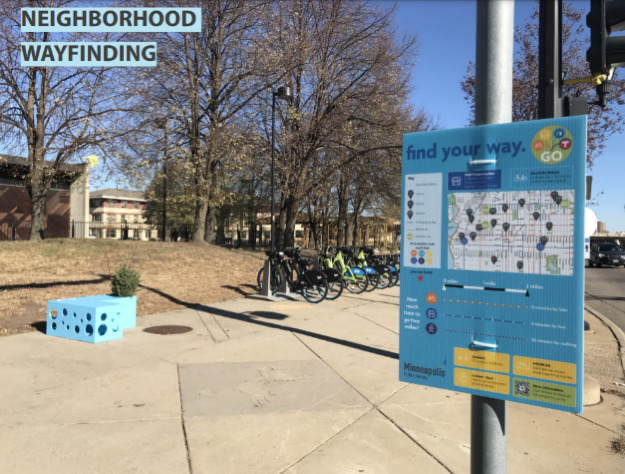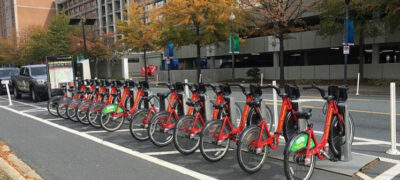3.1 How Does Micromobility Interface with Public Transit?
3.1.1 Serving the “First/Last Mile”
Micromobility is a solution to the first mile/last mile problem in transit planning, sometimes called the “missing mile.” This problem refers to the segment of a trip between a traveler’s ultimate origin or destination and the stop or station where they board or alight transit. If that distance is too far—longer than half a mile, to most Americans—the traveler may consider transit a less desirable option (Jaffe 2016). But micromobility has the power to expand the “catchment area” of transit—that is, the perceived radius of accessible places beyond the actual transit facility. With micromobility situated at transit stations, travelers can reach their final destinations much faster than walking; similarly, if a shared bike or scooter can be found near the start of a passenger’s trip, that passenger may be more inclined to take that vehicle to a transit facility and continue their journey on transit.
The need to address the first/last mile is even more critical in small metro, tribal, and rural settings where development densities may be lower and distances between transit services and one’s end destination greater. Micromobility services are flexible in meeting first/last mile needs. Unlike fixed-route transit where each additional hour of service carries with it additional operating costs like driver labor and fuel, micromobility costs are more tied to capital costs and utilization. While 100 revenue hours of bus service can cost the same to operate regardless of ridership, a low ridership bikeshare program in a lower-density community would require proportionally fewer resources to operate than a system of a similar size in a high-density location with lots of ridership.
Research on micromobility trip data, which is limited to larger cities, shows that there is some correlation between the location of micromobility trip starts and ends and major transit stops. In Arlington County, Virginia, 42 percent of trip origins or destinations fell within a quarter-mile radius of a metro station, and in Oakland, 30 percent did (Murphy et. al. 2021). In four of the five cities studied by Murphy et. al., at least 75 percent and as many as 99 percent of scooter trips started or ended within one mile of major public transit services. In a different study conducted in Washington, D.C., between eight and 12 percent of all pre-pandemic e-scooter trips connected to Metrorail (Yan 2021).
Some micromobility critics harbor concerns that these shared vehicles replace transit trips; the data show that more often they replace car trips and complement transit trips. A study in the Twin Cities on the relationship between bikeshare and transit found that four percent of bikeshare trips competed with transit, while 30 percent complemented transit; the authors also posited that the competitive trips could potentially have acted as first-/last-mile trips to transit (Song 2020).
In order for micromobility to be an attractive option to access or egress transit, vehicles must be available to be picked up or parked at transit facilities. Whether docked or dockless, this requires a rebalancing effort to suitably meet demand; if, for instance, passengers consistently find that the bikeshare dock at their major transit facility is empty, they will not consider micromobility a reliable last-mile solution. Assuming a micromobility vehicle is available, a passenger’s propensity to take micromobility at a transit facility is increased by the presence of safe, convenient, and protected infrastructure in the vicinity of that transit facility, as well as the availability of services that promote and facilitate the integration of micromobility and public transportation, which are discussed in further detail below (Oeschger 2020). Generally, micromobility programs in smaller communities do not need the same scale of rebalancing operations as large city systems due to lower overall ridership.
3.1.2 Transit and Micromobility Integration
Riders are more inclined to use micromobility in conjunction with transit when the use of both modes, and the transfer between the two, is simplified. Integrating these modes can take several forms:
- Physical integration, wherein micromobility and transit infrastructure are collocated.
- Informational integration, wherein physical wayfinding markers direct riders between modes.
- Digital integration, a subset of informational integration, wherein a rider’s trip-planning app suggests a transit route that incorporates a share micromobility mode.
- Fare integration, wherein there is a common payment method between modes or there is a discount (partial or full) for transferring between transit and micromobility.
- Institutional integration, wherein one agency is responsible for managing multiple modes.
Taken together, all these types of transit and micromobility integration improve reliability, affordability, and flexibility of multimodal trips; increase multimodal ridership; and expand the population within an accessible distance of transit facilities (Institute for Transportation & Development Policy 2021). These are best practices to ensure micromobility and public transit complement rather than substitute each other.

Physical integration takes two forms: ensuring that there is safe infrastructure for cyclists and scooter users leading to and from transit facilities and ensuring that micromobility vehicles are available to be picked up or parked at transit facilities. Safe infrastructure is often not the purview of a transit agency but instead a local government department, typically transportation or public works. Transit agencies can work with local governments to coordinate bike infrastructure investments.
In the case of a traditional docked bikeshare program, transit providers should allocate space for a set of bike docks at or near the transit facility. For dockless bikes, scooters, or mopeds, transit providers can designate “micromobility parking corrals,” or a painted space on the ground marked for exclusive parking of micromobility vehicles. Geofencing technology can allow dockless vehicles to be locked only in specific areas, facilitate the clustering of these vehicles only in marked areas.
In many settings, the colocation of micromobility infrastructure, transit facilities, and other shared mobility services is branded as a “mobility hub.” In Minneapolis, mobility hubs are being deployed not only to grow first-/last-mile connections but also to serve as centers of placemaking for residents to learn about new methods of mobility—thus, achieving both physical and informational integration. They have bright wayfinding signs, shelters and seating, and information about the variety of modes accessible at that hub (Gray 2019). These efforts make conditions more pleasant for users of both micromobility and transit.
Beyond just physical wayfinding signs, digital integration helps connect transit users with micromobility, and vice versa, before they begin their journeys. Trip-planning apps like Google or Apple Maps, Transit, and Citymapper all offer transit directions that can, depending on location, string together transit and micromobility modes into one suggested route. These apps are fed information from a General Bikeshare Feed Specification, or GBFS, which is the open data standard for shared mobility (see 4.5, Technology and Organizational Requirements). If a bikeshare or scootershare program generate a GBFS feed—then those services can appear in a third-party trip planning app. If the system is run manually, then operators may need to lean more heavily on physical wayfinding rather than digital integration. Still, even a smaller system can offer customers information digitally with minimal effort: a bike library’s website could show the number of available bikes currently as well as the number due back within the next week.
Fare integration between micromobility programs and transit is still rare but exist in a few systems. In Los Angeles, one can use the regional transit farecard, TAP, to pay for LA Metro Bike Share, as well as any other mode operated by LA Metro or the 25 other transit providers in the region. When Metro brought its bikeshare program under the TAP card, it also reduced the per-trip price in half—from $3.50 to $1.75—to be equivalent to a one-way bus or rail fare. Metro is exploring the possibility of offering a free transfer from bus or rail to bikeshare within two hours—the same window that is currently allowed for a free transfer between bus and rail (Linton 2018). Agencies can also offer a weekly or monthly pass for unlimited transit and micromobility trips at a higher price than a transit-only pass but still priced competitively for someone who rides transit and shared micromobility modes frequently.
While ideally fare integration ideally allows the user to apply one payment platform or physical devise for transit and micromobility, providing such integration can pose technical obstacles. A transit provider could allow for a visual inspection onboard the bus of a fare product purchased for micromobility services that allows free rides on transit. Alternatively, the user may be required to utilize two separate fare payment systems for transit and micromobility, with a QR-code or access code linking the two.
Institutional integration is discussed in the following section, Partnership Approaches.
3.2 Partnership Approaches
Transit agencies can take varying degrees of ownership over micromobility services, operating the system themselves, contracting or subsidizing services, or permitting third-party operators who operate independently. Often, the decision about the governance model is determined by the capacity of the agency to assume operations of a new service and the leverage the agency has in attracting an outside mobility company. These approaches are discussed in further detail below.
3.2.1 Transit Agency Operated or Sponsored Systems
A handful of transit providers across the US have established their own micromobility programs, principally with bikeshare. This produces natural synergies: for example, as noted above, Los Angeles residents can use the same farecard to access LA Metro rail, bus, and bikeshare, simplifying the payment process for riders. Directly operating a micromobility system allows transit operators to have greater control over distribution of bikes and scooters, pricing, marketing, and goal setting. In return, transit agencies need to be sure they have the staff capacity to take on these responsibilities. Transit providers may choose to contract out actual operations to a third party or operate the program with their own staff.
One of the few rural transit agencies to directly operate bikeshare is the Crawford Area Transportation Authority (CATA), serving Crawford and Venango counties in Northwestern Pennsylvania. CATA’s bikeshare, which began operations in 2021, was sponsored by a combination of funding from a newly established local non-profit that applied for grant funds, an allocation from the CATA board, and donations from private businesses and other local community entities. In its first year, with 20 bikes, the system was run entirely by existing CATA staff, with the agency’s general manager frequently rebalancing bikes himself. While this is a big job for the existing staff, the primary reason to pursue this method of funding and direct operations was to allow the goals, dock siting, and marketing to be controlled by the local community.
The Greater Dayton Regional Transit Authority (RTA) may go further than any other transit agency in the country with respect to scootershare: it directly operates its e-scooter service. While the scooter company Spin provides Dayton its fleet and digital app, RTA is responsible for all maintenance of scooters, including rebalancing. Taking this hands-on approach has allowed RTA to streamline operations and align metrics of success with agency goals. For instance, in Dayton, Spin considered a key success metric to be the number of scooters deployed by 7 a.m., while the city and the agency were more interested in shrinkage rates (i.e., the number of scooters that were lost, damaged, or stolen) and maximizing utilization of the existing scooter fleet (American Public Transportation Association 2020).
Partnerships Case Study: CARTA and Chattanooga Bike Share
The Chattanooga, Tennessee, transit system (CARTA) launched one of the first bikeshare systems in the country in 2012 and was also one of the first to be operated as a partnership with the local transit agency. Originally, CARTA was supposed to operate the bikeshare system directly; labor and liability concerns resulted in the agency opting to pursue a partnership approach instead. Bikeshare advocates convinced CARTA leadership to allow the agency to be the fiscal house of the project by owning and managing the assets, while the management of the operations would be handled by Outdoor Chattanooga, a local non-profit that works with the city’s parks and recreation department.
CARTA and Outdoor Chattanooga decided to partner with a private company to operate the system, who is responsible for all bike rebalancing, maintenance, smartphone application, etc. As CARTA promised the city council that the system would be financially stable, in its first years of operation the private operator absorbed the system’s losses, but now the system has fully covered revenue through a mix of system revenue, private donors, grant funding, and support from the MPO and RPA. The city recently gave the system $100,000 in matching grant funds, but prior to that had not given any money to the system.
In 2013, the city took over control of asset ownership and management from CARTA, so the transit agency no longer has a direct relationship with bikeshare operations. However, CARTA continues partnering with the bikeshare system in a multitude of ways. CARTA supports grant applications for bikeshare, and the programs coordinate the placement of new bikeshare stations and bus stops. Additionally, CARTA introduced a stored-value RFID card and app-based payment system that works for both transit and bikeshare and provides discounts to incentivize users to utilize both systems.
Furthermore, CARTA operated an electric carshare system from 2016-19 and intended to extend the card and app payment to include carshare and parking garages as well as bikeshare and transit. However, the private operator that ran the carshare system for CARTA was unable to sustain the system’s losses, and it closed in 2019. However, CARTA still owns and operates the network of electric vehicle charging stations left behind. Ultimately, CARTA hopes to integrate parking resource management into transit and bikeshare operations and eventually bring back carshare, with the aim of being a one-stop-shop mobility-as-a-service provider for the city.

3.2.2 Permitting and Private Partnerships
Another way that transit providers can work with micromobility providers is through regulations and permitting of those services. As discussed later, a common business model for micromobility is to permit a private firm to operate the service within the city; in exchange for access to the public right-of-way, these micromobility services are required to follow certain regulations, provide specific community benefits, and even share a portion of their revenue with the host jurisdiction. Transit providers (often in coordination with the local governments responsible for overseeing micromobility programs) can leverage the permitting system to better integrate micromobility programs with their services. Several large cities have used their permitting program to generate additional public revenue and achieve public policy goals, such as requirements to locate vehicles in historically disadvantaged neighborhoods.
Generally, large cities have greater leverage to attract a micromobility system than a small urban, rural, or tribal community. For smaller communities, strict or onerous permitting requirements could deter a micromobility operator. Jurisdictions and transit providers instead should consider how regulations and permitting strategies can be a win-win for both the public and micromobility providers. For example, a transit provider may establish a permitting program that allows micromobility vehicles to be parked at designated locations beside bus stops or at transit centers. The permit may stipulate certain performance requirements (e.g., minimum response times in instances of a complaint) in exchange for access to the transit provider’s property. Similarly, a micromobility provider may invest in payment integration between their services and transit in exchange for cross-promotion of the service by the transit provider.



